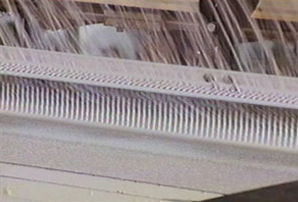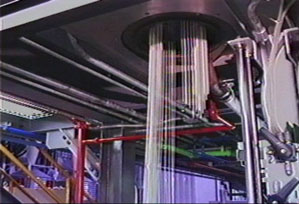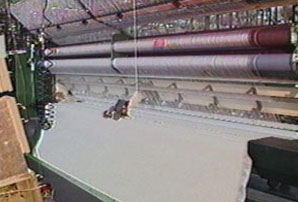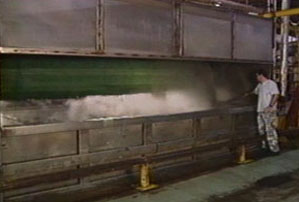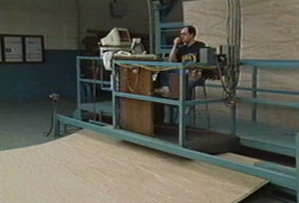Carpet How It's Made
Knowing how carpet is made can be very advantageous. Knowing the different materials that make up various carpets also helps you understand and evaluate their performance aspects: why certain carpets are easier to install, why some wear better, longer, and why others are easier to care for and clean. It can also make you a smarter shopper.
Selections:
- Thicker is not always better
- A tight twist in each yarn is better than loose and frayed
- Firm and dense pile means quality
- The more backing seen, the less dense and durable
- High traffic areas need lower profiles to avoid matting and crushing
Step 1: Fiber
- Basic material of makeup
- 90% is synthetic fiber
- Rest is natural fiber, mostly wool
Synthetic Fibers
- Made up of 1 of 3 materials: nylon, polypropylene or polyester
- Created by chemical processes from oil and natural gas
Nylon
- 75% is made of nylon
- Performs the best overall
- Leader in: appearance retention, fade and heat resistance, soil and stain resistance, color and styling
- Highest performance nylon is Type 6.6 for more resistant to stain penetration
Polypropylene
- Next most common material is polypropylene
- Introduced in the late 1950's in Italy
- BCF represents more than 35% of all fibers
- Not as resilient or resistant to abrasion as nylon
- Natural stain and fade resistant
- Naturally resistant to moisture
- More limited range of color options
- Most often used in loop pile constructions
Polyester
- Third type of material is polyester
- Introduced to the carpet industry in the mid-1960 's
- Well accepted for bulkiness, color clarity, and good stain and fade resistance
- Not as resilient as nylon
- Can be a good performer
PET
- Mohawk makes from plastic bottles
- Plastic is collected, separated by color, and then ground and melted
- Used to manufacture the PET carpet fiber
- Carpets of PET staple fiber are made from 100% recycled material
- Great color clarity, stain resistance, durability
- Keeps over 3 billion bottles out of landfills
SmartStrand
- Made with DuPont Sonora polymer
- DuPont and Mohawk make this fiber into carpet
- SmartStrand with DuPont Sorona is continuous filament fiber
- Eliminates shedding
- Highly stain resistant and durable
- 40% of the fiber made from corn by-products
Wool
- The above three materials make up the majority of synthetic fibers.
- The other type of fiber used in carpet construction is staple fiber.
- While some synthetics are used in the creation of staple fibers, the original staple fiber used in the making of carpet is wool.
- The wool used in today's carpet comes primarily from New Zealand, Argentina, and the United Kingdom.
- Since wool is a natural fiber, it ranges in color from off-white to black, with many earthen tones between.
- Wool doesn't stand up to abrasion and moisture as well as synthetics, it cleans well and is known to age gracefully.
- Wool is the most expensive carpet fiber and represents less than one percent of the U.S. carpet market.
Berber
- Considered a type of carpet construction
- Actually comes from the name of a group of North African sheepherders called the Berbers
- Berbers produced coarse wool with color flecks in their yarns
Carpet is made in a 3-part process.
#1 Tufting
- Begins with weaving the synthetic or staple fiber into a primary backing material
- Usually made of woven polypropylene
- Main value is to provide a base cloth to hold the yarn while tufting happens
- Tufting machine has 800 to 2000 needles like a sewing machine to pull the yarn through the primary backing material
- Tufting machine is 12 feet wide, its needles penetrate the backing and a small hook (looper) grabs the yarn to holds it in place
Loop pile construction
- Holds appearance well
- No exposed yarn tips
- Only sides of the yarn are exposed to wear and stress
- Known to hold up the best
Alternative step
- Sometimes the looper cuts small loops creating a cut pile
- Length of these pieces called pile height, or distance between the looper and primary backing
- Cuts are controlled by a computer and can be programmed to cut only some of the loops
- This cutting is called cut and loop construction and creates pattern on the surface
#2 Application of dye
Two dyeing processes
- Yarn dyeing / pre-dyeing - color is applied to the yarn prior to tufting
- Advantages are good side-by-side color consistency, large lot sizes, and uniformity
- Carpet dyeing - applying color to the yarn after tufting
- Benefits - greater color flexibility
Carpet dyeing methods
- Beck/batch dyeing - stitching the ends together, then running the tufted carpet loop through large vats of dye and water for several hours.
- Beck process ideal for small runs, heavier face weight products
- Continuous dyeing (similar to Beck dyeing) - carpet is also run through processes other than dyeing
- Continuous dyeing - applies color to the face by spraying or printing, also to create multicolor or patterned effects
- Screen printing - color is applied through anywhere from 1-8 silk-screens.
#3 Manufacturing the carpet
- Finishing process- single production line that completes the final construction stages
- Coating of latex applied to dyed carpet's primary and secondary backing
- Secondary backing - made of woven synthetic polypropylene
- Two parts are squeezed together in a largely heated press and held firmly to preserve the shape
- Shearing- removing loose ends and projecting fibers created during the tufting process
- Also helps the yarn's tip definition
- Inspection - for color uniformity and defects before it is rolled, wrapped and shipped
Terms and construction variables
Pile height, or nap
- Length of the tuft measured from the primary backing to the yarn tips
- Shown as a fraction, or decimal equivalent
- Shorter pile is more durable than longer pile
- Stitch rate - measure of how close the yarns are together
- Stitch rate is measured in penetrations, or tufts, in a given length of carpet, usually an inch.
- Stitch rate is controlled by the speed the carpet is moved through the tufting machine
- Good number is seven to eight tufts per inch
- Face weight-actual amount of fiber per square yard, measured in ounces
- Typical carpet may have a face weight of 35 to 45 oz
- Density- how tightly the yarn is stitched into the primary backing
- Higher density will wear better than low density








